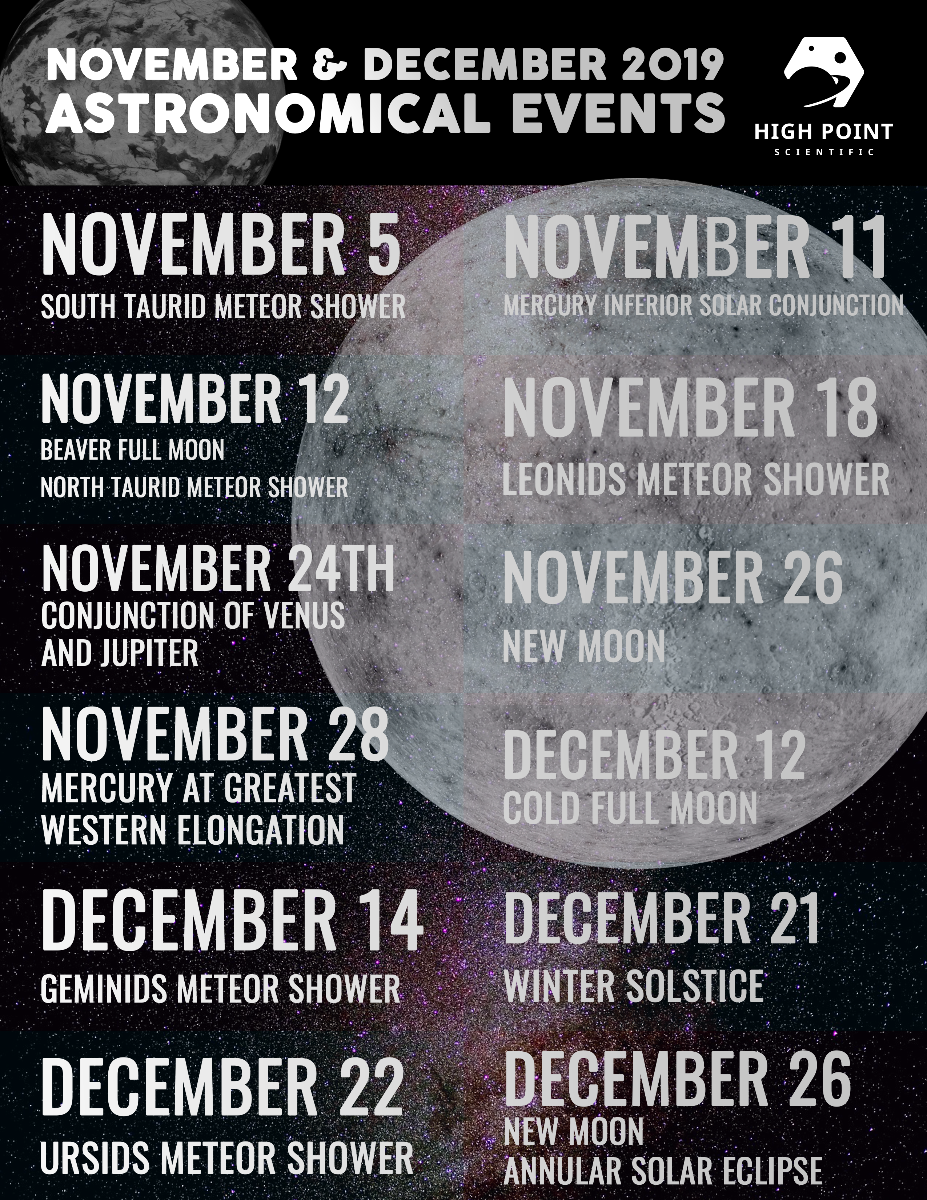
Be sure to step outside and enjoy some really interesting celestial events taking place over the last two months of 2019! The Transit of Mercury gives solar astronomers a breathtaking event to look forward to, as Mercury makes its way across the face of the Sun, and the Leonid & Geminid meteor showers are always a treat! Enjoy!
Please Note: These 2019 celestial events happen all around the world, from the USA to South America; from Russia to Australia. While we are using our local time (ET) for many dates throughout this calendar, we also use UTC, or Universal Time, with events that are super time-dependent, such as a solar or lunar eclipse. In these instances, you will need to calculate your local time from one of the many online time converters or charts.
November
In Process - South Taurid Meteor Shower - The Southern Taurids are a quieter meteor shower, normally producing between 5 - 10 meteors per hour, but they are also responsible for a larger than normal number of fireballs, or meteors that are brighter than usual and often leave lingering streaks in the sky. The South Taurid shower is made of dust and pebbles from Comet Encke. These weightier pebbles are known for producing colorful fireballs as they burn up in our atmosphere, creating a spectacle of lights in the sky. With minimal moonlight from the crescent Moon in early November, the South Taurids could be an excellent opportunity to see some of these rare fireballs! While there is some disagreement regarding the actual peak of the southern stream of the Taurids, you will be able to see meteors attributed to the shower streaking across the sky through most of November. All meteor showers are named after the constellation they radiate from, and this shower radiates from Taurus the Bull.
November 11 - Transit of Mercury - Catch Mercury traversing across the Sun during this rare planetary transit. On November 11, we can watch Mercury’s small dark sphere make its way across the face of the Sun during this truly unique solar event. The transit of Mercury will be the highlight of this winter because planetary transits occur much less often than oppositions or solar eclipses. The eastern portion of North America and all of South America will be able to catch the transit of Mercury in its entirety on the morning of November 11 from about 7:36 a.m. to 1:03 p.m. When viewing this spectacular solar event, be sure to use equipment that will keep your eyes safe from sun damage. A dedicated solar telescope or telescope fitted with a safe solar filter will provide the best views (Mercury will just be a tiny dot on the Sun), but however you view this event, make sure you protect your eyes! We will not see another transit of Mercury until 2039, so don’t miss out!
November 12 - Beaver Full Moon - The night of November 12 marks the Beaver Moon. November’s full moon is known by this name because beavers build their winter dams at this time. While we may not see the beavers out this night, the evening of November 12 provides a good chance to observe the Moon, whatever its name, in all of its splendor.
November 12 - North Taurid Meteor Shower - The second portion of the Taurid Meteor Shower peaks on November 12, which, unfortunately, coincides with the full moon. That doesn’t mean you won’t see any meteors on that night, it just means those you do see will have to be bright, especially when the moon is nearest the radiant. Keep in mind, however, that the Taurids produce more than their share of very bright meteors (fireballs or bolides) and the South Taurids are still adding to the mix, do don’t give up! Just like the South Taurids, the northern stream is made of debris from Comet Encke and the radiant will come from the constellation of Taurus.
November 17 - Leonid Meteor Shower - Comet 55P/Tempel-Tuttle is responsible for the Leonids, a lovely shower with an hourly rate of 15 and the possibility of occasional outbursts just to add suspense to your evening’s observations. With a radiant located in Leo the Lion, meteors can be seen dashing away from this kingly constellation, creating long meteor trails. Because meteor trails will be shortest near the radiant, we suggest you scan the skies on either side of Leo to increase your chance of seeing one of the Leonid’s signature bright meteors with long, persistent trains.
November 24 - Conjunction of Venus and Jupiter - Witness Venus and Jupiter neck and neck in the early evening sky on November 24! For the best views, find a location that gives you an unobstructed view of the western horizon at sunset. Venus will be the brighter of the two, but Jupiter will put on quite a show as well!
November 26 - New Moon - The Moon will not be visible in the night sky on November 26. This is the perfect time to break out your telescope to view or image faint celestial objects such as star clusters, galaxies, and nebulae.
November 28 - Mercury at Greatest Western Elongation - When at Greatest Western Elongation, Mercury will be the highest in the sky that it will get during this orbit around the Sun. Since Mercury usually hovers around the horizon, this will be the best chance to see it or capture an image of the planet. Mercury will be visible just above the eastern horizon about 20.1° from the Sun right before sunrise.
December
December 12 - Cold Full Moon - You’re not going to believe this, but winter is cold in many parts of North America! That is why December’s Full Moon is called the Cold Moon. In fact, December is often considered the coldest month of the year, bringing snow, sleet, and ice along with it. Maybe its time for some backyard observations of the Full Moon, knowing that warmth and a cup of something hot is just a few steps away? This is also the last Full Moon of 2019.
December 14 - Geminid Meteor Shower - The Geminids are the holy grail of all meteor showers. Known to produce up to 120 colorful meteors at its peak, this shower is beloved by astronomers for its spectacle of colors sent soaring through the sky. The Geminids are named after the constellation Gemini, where you will find the radiant of this shower. The Geminids are derived from debris broken off from the asteroid 3200 Phaethon. Although there will be significant moonlight this year, the Geminids produce such bright and numerous meteors that it’s still worth getting outside to take a look.
December 21 - Winter Solstice - Winter officially begins in the Northern Hemisphere at 11:19 p.m. ET on December 21. Winter Solstice marks the longest night of the year and the shortest day, however on December 21 folks in the Southern Hemisphere will be enjoying the longest day of the year and the shortest night, or Summer Solstice! How does this work? It all has to do with the tilt of the Earth’s axis. Winter Solstice marks the time when a hemisphere is tilted the furthest away from the Sun, and for the northern half of the planet, this happens around December 21 each year.
December 22 - Ursid Meteor Shower - This minor meteor shower is often overshadowed by flashier showers, but the Ursids may be just as interesting to watch this year. Minimal moonlight is expected, so you will be able to see up to 10 meteors per hour at its peak on December 22. The radiant is within the Ursa Minor constellation, but meteors can be seen anywhere in the northern sky shooting away from this location.
December 26 - New Moon - The final New Moon of 2019 will take place on December 26. The New Moon is a great time to grab your telescope (maybe a new telescope you received as a holiday gift!) and enjoy a night of observing without moonlight.
December 26 - Annular Solar Eclipse - The Annular Solar Eclipse on December 26 is unlike any other eclipse that you will experience this year if you are lucky enough to live in or travel to the Middle East or South Asia. This special partial eclipse occurs when the Moon passes in front of the Sun but does not block out its outer edges. Depending on your location, the annular eclipse begins at 02:29:53 UTC, and the Moon will slowly move in front of the Sun, making the sky darker and darker, until only the outermost edges of the Sun are visible. During this time, at about 05:17:46 UTC, the Sun will look like a bright, fiery ring against a dark sky. As the Moon moves away from the Sun, the sky will grow brighter until daytime is restored. This unique solar eclipse will be completely visible in parts of Saudi Arabia, United Arab Emirates, India, Sri Lanka, and Malaysia; although a partial eclipse can be seen from much of the Middle East and South Asia. Like all partial solar eclipses, make sure to wear proper eye protection when viewing the Annular Solar Eclipse from start to finish.
